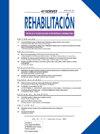超越认知:对西班牙康复医生群体评价量表的调查结果
IF 0.4
Q3 Medicine
引用次数: 0
摘要
康复测量是客观化患者功能状态、确定和评估干预措施、监测治疗进展的基本支柱。然而,它在临床实践中的应用在医生中还不够广泛。目的了解西班牙物理与康复医学(PRM)医师在临床实践中对测量仪器尤其是经验证的量表的使用习惯。方法设计并分发一份结构化调查,包括11个强制性李克特型问题,涉及临床实践、可用时间、量表和评估工具的使用、感知障碍和培训需求。数据分析采用描述性统计和相关分析。结果390名专业人员中,61.8% (n = 241)报告系统地使用了某种类型的测量工具。共有53种不同的量表被报道,Barthel指数是最常用的(42.3%,n = 103)。未使用量表的患者(n = 95)依靠记忆和体格检查来评估患者的进展。确定的主要障碍是缺乏时间(78.4%,n = 135)。在较长的咨询时间和常规使用量表之间观察到显著的关联(P<.001)。此外,76.9% (n = 297)认为缺乏培训是一个障碍,94.8% (n = 365)表示有兴趣接受特定的培训。结论尽管大多数PRM医生使用测量量表,但时间有限和缺乏培训等重要障碍仍然存在。通过组织和教育策略解决这些因素可以帮助促进在临床实践中更广泛地采用测量工具。本文章由计算机程序翻译,如有差异,请以英文原文为准。
Más allá de la percepción: resultados de una encuesta sobre escalas de valoración al colectivo de médicos rehabilitadores en España
Introduction
Measurement in rehabilitation is a fundamental pillar for objectifying the functional status of patients, determining and evaluating interventions, and monitoring treatment progress. However, its use in clinical practice is not yet sufficiently widespread among physicians.
Objective
To describe the usage habits of measurement instruments, particularly validated scales, in the clinical practice of Spanish physical and rehabilitation medicine (PRM) physicians.
Methods
A structured survey was designed and distributed, consisting of 11 mandatory Likert-type questions related to clinical practice, available time, use of scales and assessment tools, perceived barriers, and training needs. Data were analyzed using descriptive statistics and correlation analysis.
Results
Out of 390 professionals, 61.8% (n = 241) reported using some type of measurement tool systematically. A total of 53 different scales were reported, with the Barthel Index being the most frequently used (42.3%, n = 103). Those who did not use scales (n = 95) relied on anamnesis and physical examination to assess patient progress. The main barrier identified was lack of time (78.4%, n = 135). A significant association was observed between longer consultation times and routine use of scales (P<.001). Additionally, 76.9% (n = 297) cited lack of training as a barrier, and 94.8% (n = 365) expressed interest in receiving specific training.
Conclusion
Although a majority of PRM physicians use measurement scales, important barriers such as limited time and lack of training remain. Addressing these factors through organizational and educational strategies could help promote wider adoption of measurement tools in clinical practice.
求助全文
通过发布文献求助,成功后即可免费获取论文全文。
去求助
来源期刊

Rehabilitacion
Medicine-Rehabilitation
CiteScore
0.80
自引率
0.00%
发文量
63
期刊介绍:
La revista que es desde hace más de 40 años la publicación oficial de la Sociedad Española de Rehabilitación y referente de la mayoría de las Sociedades de la Especialidad de los países americanos de habla hispana. Se publican 5 números pluritemáticos al año y uno monográfico sobre un tema del mayor interés y actualidad designado por el consejo de redacción.
 求助内容:
求助内容: 应助结果提醒方式:
应助结果提醒方式:


